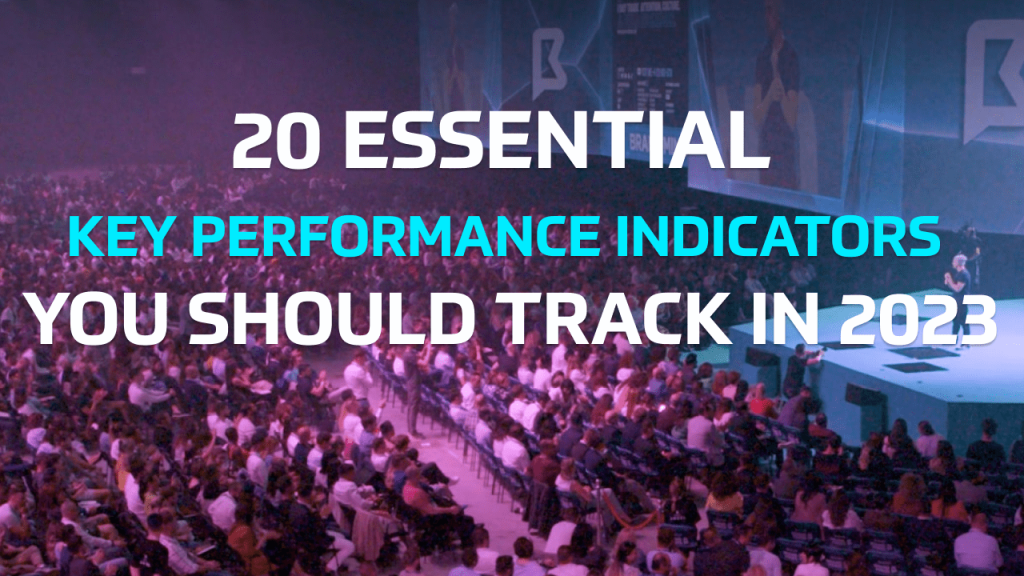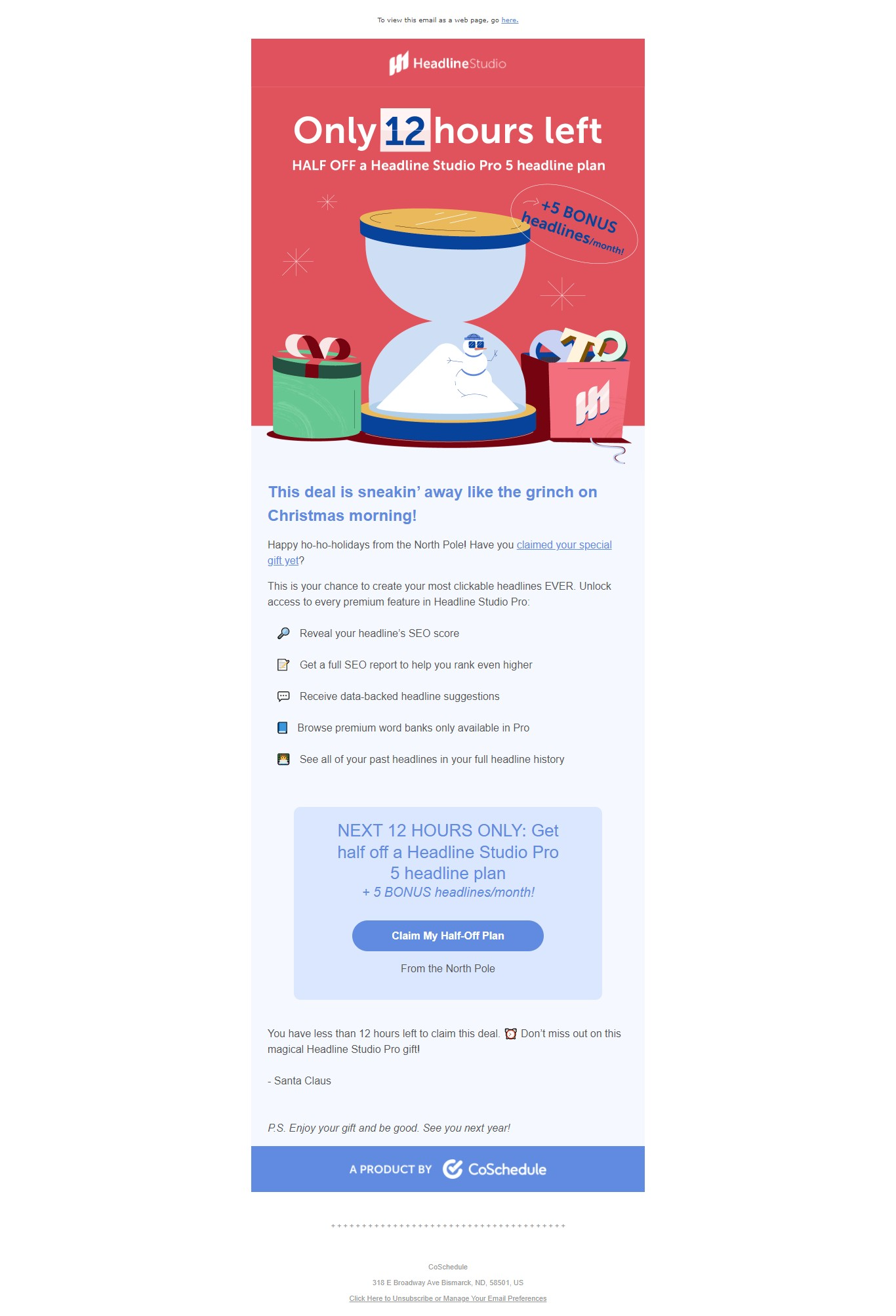20 essential KPIs you should be tracking to improve your marketing
Looking to learn about KPIs and how you can use them to improve your marketing? Then this article is for you!
Table of Contents
What is a KPI in marketing?
KPI stands for key performance indicators.
A KPI in marketing is a measurable value tied to the specific objectives of a marketing campaign.
KPIs help measure marketing effectiveness at the end of a campaign.
KPIs vs marketing metrics
Isn’t KPI the same as marketing metrics?
No, it’s not and you must be able to know the difference between KPIs and marketing metrics.
Marketing metrics are measurable values that include everything from the number of followers of the brand’s page on Facebook, Instagram, YouTube, TikTok to website traffic, email subscribers, MQL (marketing qualified leads) and the list can continue. It’s everything you can measure at any given time.
The KPI belongs to the marketing metrics category, it is indeed a marketing metric itself.
The difference is that the KPIs are tied to a specific goal of a specific marketing campaign whereas marketing metrics are not tied to a specific goal of a specific marketing campaign.
Every marketing campaign has one or several marketing goals. To measure how effective your campaign was to achieve your goals, select the appropriate KPIs.
How are KPIs used to measure performance in marketing?
Before we talk about how to use KPIs to measure and track performance in marketing campaigns, it’s essential to understand the brand’s business goals and objectives.
You cannot measure progress if you don’t know what progress looks like. Or what success means for your business.
So, if you are the leader of your team, share the brand’s business goals for 2021 with your colleagues.
They could focus on revenue (increase sales), suppliers (replace old suppliers with new, more performant ones), employees (reduce employee turnover), profit (increase profit margin) or market (increase market share).
Once everyone in your team is aware of the business goals they need to achieve, you can move on to the next step: establishing marketing goals.
Here are some of the common marketing goals:
- Increase Brand Awareness
- Lead generation
- Promote new products/services
- Target new customers
- Increase website traffic
- Grow your email list
If your business goal is to increase revenue, what marketing campaigns your team needs to create and run in order to achieve it?
You could consider implementing several marketing campaigns. For example, a marketing campaign targeted at new customers or a marketing campaign targeted at your current customers with the goal of upscaling. What would you like them to do: buy more in quantity or buy products that are more expensive?
The KPIs tied to this particular marketing campaign could be 20% new leads generated or 20% customer conversion rate.
Here are 20 essential KPIs that you should track to measure your marketing performance:
- Email open rates
- Email click-through rates
- Email forward rates
- Newsletter signup conversion rate
- Social media engagement rate
- Social media conversions
- New leads generated
- Cost per lead
- Customer lifetime value
- Returning website visitors
- Goal completion rate
- Marketing revenue attribution
- Customer acquisition cost (CAC)
- Landing page conversion rates
- Traffic-to-lead ratio
- Lead-to-customer ratio
- Customer retention
- Content downloads
- Referral traffic
- Net promoter score
1. Email open rates
You worked hard to gain new subscribers to the company’s newsletter, but all is in vain if your emails remain unopened.
Optimize your headlines. Are you sending too many emails per week? If you do, but your subscribers don’t click the unsubscribe button, then they wish to receive your emails but they are too often which leads to email fatigue.
2. Email click-through rates
Your subscribers are opening your emails – that’s great! One of your email campaign goals is to drive website traffic so the email clickthrough rate is an important KPI.
If you note this particular indicator is unsatisfactory (what value did you set for email clickthrough rates?) because the subscribers are not clicking on the links, you should consider the content and the copy. Is the linked content relevant to subscribers?
Re-write the copy: don’t use ‘learn more’ to persuade the subscriber to click the link. Get creative!
3. Email forward rates
The email forward rate is one of the most important KPIs if you are looking to grow a community for the brand.
Opening the email and clicking on the content links inside is one thing, but making your message so relevant to your subscribers that they forward it to someone else is a great achievement.
4. Newsletter signup conversion rate
How many people did your email subscribing campaign convert?
This KPI shows how well you were able to find a match between the brand’s offering and their interests, to speak to their values and show them your solution to their pain points.
5. Social media engagement rate
They say liking a post is the easiest engagement action that your followers can take whereas commenting is the hardest.
Having followers that take the time to express their opinion in a comment to your post is more valuable than receiving likes. It also tells the algorithm that this piece of content is sparking conversations which prompts it to show your post to more people.
6. Social media conversions
It’s nice to have a big number of followers on social media accounts, preferably in the millions. It is an indicator that the brand is popular and a lot of people want to stay connected with the brand.
After having said that, let’s also not forget that the algorithm shows your content to a small number of people. Some say it’s under 1%. So this vanity metric is a nice-to-have feature, but it is not essential.
What is instead relevant is how many conversions does your social content drive? How many clicks to the website? How many email subscribers? How many leads does it generate?
7. New leads generated
Generating new leads is paramount for every brand. You need to constantly show your products or services to new leads gently nudging them to the next step in your marketing and sales funnel.
Check this to get your creative juices flowing: 5 fast ways to generate leads on your website
8. Cost per lead
Lead generation is important, but if the cost of acquiring leads is high, you need to take a step back, analyze every stage of the process and see where you can improve it.
The Pirate Funnel may help you pinpoint where your business is losing customers.
9. Customer lifetime value
Customer lifetime value is the total revenue you can expect from a customer during the period that they remain a customer. Or simply put: how much are they worth to your brand? For example, Amazon Prime members are worth twice as much as non-Prime shoppers. Prime shoppers spend $1,340 annually, more than twice as much as non-Prime shoppers, who spend $650 annually.
10. Returning website visitors
Having a good amount of website traffic is necessary if you want to run ads, show up in organic search results and gain email subscribers.
Your website is owned media, it’s where you control the content – your brand is not at the mercy of any social media algorithms. It’s important to measure the number of new visitors your website gets every month. But equally important is to track how many visitors return to your site.
Returning visitors tell you that your website is a relevant and valuable resource for them. It’s how your brand stays top of mind. It’s also easier to convert returning visitors to leads and then customers.
11. Goal completion rate
Marketers set a goal for every marketing campaign they run. The goal completion rate is a KPI that measures the number of people that complete a specific marketing goal.
How many people subscribed to the brand’s newsletter? How many people have signed up for your freemium offer? It is an important indicator of your brand’s ability to influence to get from the awareness stage to the consideration stage in your marketing funnel.
12. Marketing revenue attribution
Every marketer wants to know how much profit their campaigns have generated. The marketing revenue attribution KPI does exactly that: it tracks and credits the company’s marketing efforts with the generated revenue.
If you are running mobile campaigns, marketing revenue attribution can prove to be a challenge. There are platforms to help you out, it’s only a matter of finding the right one for you.
13. Customer acquisition cost (CAC)
Do you know how much it costs your company to acquire a new customer?
As a business person and a leader, it’s one of the most important numbers you should be aware of. This KPI can be calculated by dividing all costs spent on acquiring new customers (advertising spend, the marketing and sales department salary costs) by the number of customers. Now that you know what your company’s CAC is, if it’s too high, you can start looking for ways to lower it.
14. Landing page conversion rates
Your team has designed a beautiful landing page for your company’s latest offering of products or services. And you are running a campaign to send leads to that landing page with the goal of converting them to customers. The landing page conversion rate KPI shows the performance of the landing page.
If the page has a poor conversion rate, analyze it to see if the graphics and the copy can be improved.
15. Traffic-to-lead ratio
This KPI tells you how many of your website visitors convert to leads. First, you need to establish what exactly means a lead for your brand.
What do you want your website visitor to do? Depending on what your company offers through its website, it could be anything from a newsletter subscribing, downloading a PDF paper, answering a survey or registering for a 7-day free product subscription.
If this ratio is unsatisfactory, one of the main questions you should ask yourself is ‘Are you attracting the right people to your website?’
16. Lead-to-customer ratio
Now that you have established the traffic-to-lead ratio, the next step is to establish the lead-to-customer ratio.
From the total number of leads, how many convert into paying customers? How many push the Buy button? What are you doing to convince them to become customers? Are your leads qualified? A qualified lead is someone who could become a potential customer to you, based on criteria and identifying information that they have freely provided.
17. Customer retention rate
The customer retention rate indicates the brand’s ability to serve and satisfy its customers so well over a given period of time that they have become loyal.
It’s every brand’s dream: customers that are happy to continue to do business. If this KPI is high, then you are doing something right. You may also consider designing a brand ambassador program as your next step. We all know that acquiring new customers is more expensive than retaining existing customers.
18. Content downloads rate
Downloadable content is usually hosted on a landing page as a lead magnet. It helps marketers establish if the content is relevant to the page visitors and if the copy is effective. The visitor who downloaded the content is now a lead and the brand can begin a conversation which could eventually result in a sale.
19. Referral traffic
Directing people to your website is hard work and it usually takes 6 to 12 months to see results for some companies or 3 months for other companies depending on the industry.
Referral traffic is one of those results and describes the people who come to your website from other sites, without searching for your brand on Google. It could be a link on your social media post, or in a blog published by one of your clients. If they are linking back to your website it means your content was helpful to them which in turn helps your brand increase awareness and domain authority.
20. Net promoter score
When we are satisfied with a product or service, we recommend it to our friends and family. It’s one of the most powerful ways a brand can attract customers – word-of-mouth marketing.
The Net Promoter Score assesses the customers’ overall satisfaction and calculates the likelihood of recommending a company or its products.
5 fast ways to generate leads on your website
Generating leads is one of the most important responsibilities of marketers in every industry. Without leads, there are no sales, and without sales, the business doesn’t survive.
So how do you generate leads fast using your most important resource: your website?
5 fast ways to generate leads on your website
- Giveaways
- Discounts
- Downloads
- Gamification
- Referral programs
Let’s break the list down and see how you can leverage every one of them to get leads for your business. If you’re looking for other ways to get leads, here are two ideas for you to explore: 3 efficient lead-generation tools and conversational marketing.
1. Giveaways
Giveaways are a great way to generate leads on your website.
What should you do to generate leads through giveaways?
You do a brainstorming session with your marketing and sales team and come up with a few ideas of what your prospects would like to receive in exchange for their email.
To turn prospects (potential customers fitting certain criteria) into leads (prospects sharing contact information with your company), your giveaway has to comply with a set of requirements.
First of all, your giveaway can be one of your products or services. If that’s not possible, your giveaway can be anything that speaks to your brand values and is in line with your customers’ interests.
Here’s an example:
Beauty and makeup brands give away beauty products, but they could also give away a makeup session with a renowned makeup professional or a skincare course with a dermatologist.
Once you have decided upon the prize you are going to give your prospects, it’s time to create a dedicated landing page on your website.
The architecture of your landing page should include the following elements:
- An eye-candy or an appealing image of your prize;
- Powerful headline;
- Enticing body copy;
- Description of your prize;
- How your prospects would benefit from your prize, when applicable;
- Contact information form for your lead’s name and mail address;
- CTA button;
- One or two questions you would like your lead to answer (refrain from including too many questions or asking for too much information);
- The time period over which your giveaway will take place (at least 7 days);
- When and how you will choose the winner/s;
- How you will announce and contact the winner.
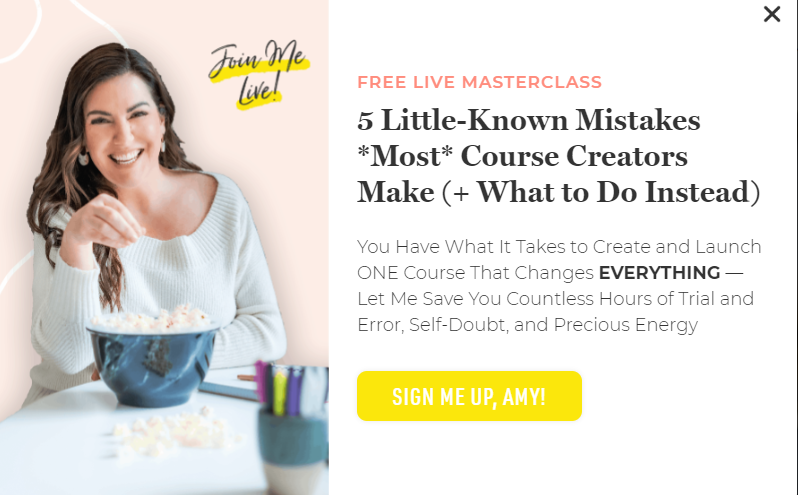
screenshot from amyporterfield.com
2. Discounts
If your product is of high value or running giveaways is not included in your brand strategy (Louis Vuitton does neither sales nor giveaways for example), you can still generate leads fast by offering your product at a discount price.
It’s a way to attract prospects who didn’t buy your product because of its price. Now they get the opportunity to buy a high-value product and become a recurring customer.
Your discount price campaign landing page should include:
- An enticing main image of your product or hero (lead);
- Your discount price clearly communicated;
- The product carrying the discounted price;
- The net price (the price the customer will pay after the discount has been applied);
- Description of your product/service;
- Benefits of your product/service;
- Contact information form for your lead’s name and mail address;
- CTA button;
- The time period over which your discount price campaign will take place (at least 7 days);
- Any other details your lead should be aware of.
3. Downloads
Generating leads with downloads is one of the most widespread ways to send prospects to the bottom of your company’s sales funnel.
But it’s not the easiest. Before creating the landing page, your copy team and your graphics team need to work together to deliver a PDF file that your leads will be prompted to download. We see this type of lead generation at tech companies like Hubspot and Adobe or research companies like Gartner and PwC.
Don’t be discouraged! Any company, no matter how small, can offer relevant information for its leads to download. It’s a matter of having an in-depth understanding of what your customers need from you.
A great benefit of download campaigns is that they are not time-limited as are the giveaways and discount campaigns. Your company can generate leads throughout the entire year.
Your download landing page should include:
- An enticing main image of your product or hero (lead);
- Description of your PDF;
- How does your PDF file help your leads (benefits);
- Powerful headline;
- Download button;
- Contact information form.
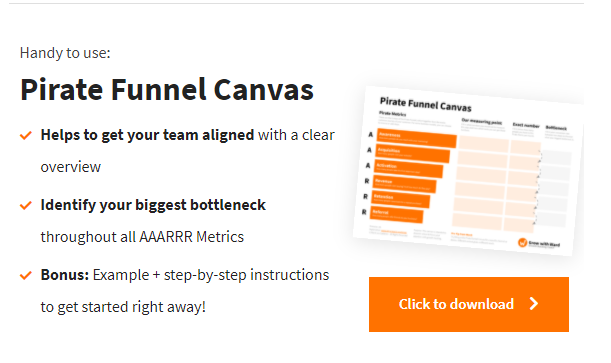
screenshot from growwithward.com
4. Gamification
While giveaways, discounts and download campaigns also support brand awareness because they foster a certain level of engagement, gamification campaigns increase lead engagement tenfold.
Again, it’s not one of the easiest ways to generate leads, but it’s more powerful than the first three.
What is gamification in marketing?
Gamification marketing is increasing engagement by incorporating gaming principles into your campaign. Gamification is psychology-based and taps into your lead’s reward centre of their brain.
Essential key points that you should take into consideration when developing your landing page:
- Bright and attractive colours to pique the curiosity of your lead;
- The game should be simple enough to understand and complex enough to stimulate the lead’s innate competitiveness;
- Invite your leads to complete the contact information form only after they’ve entered the game and are eager to finish it;
- Refrain from making the game too long;
- Give your players incentives to move on to the next stage by unlocking rewards or achievements.
Here’s a great example called Wheel of Security, a lead-generation game developed by Juniper Network:
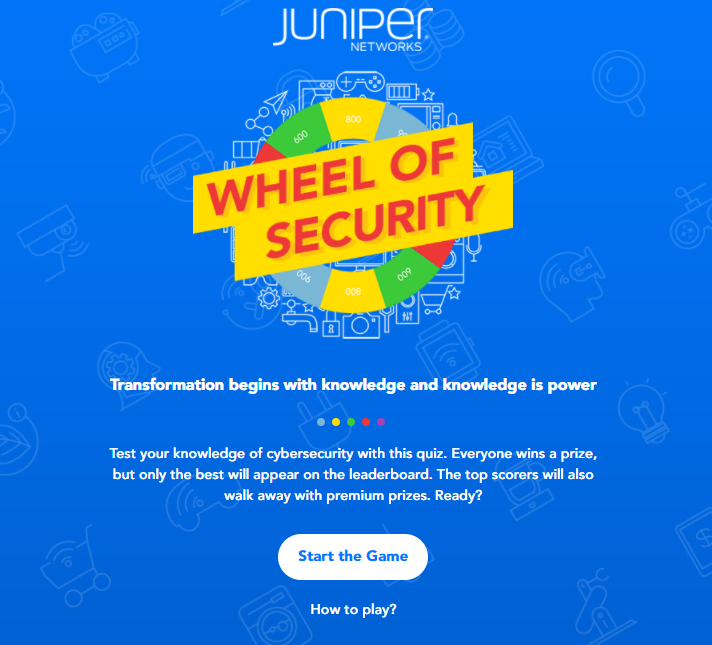
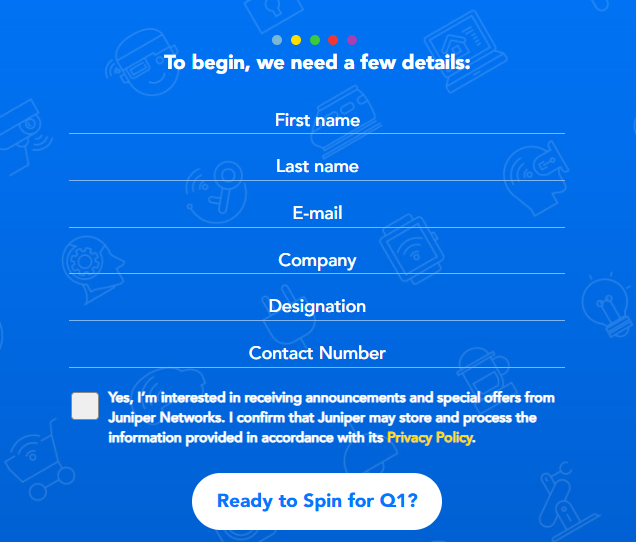
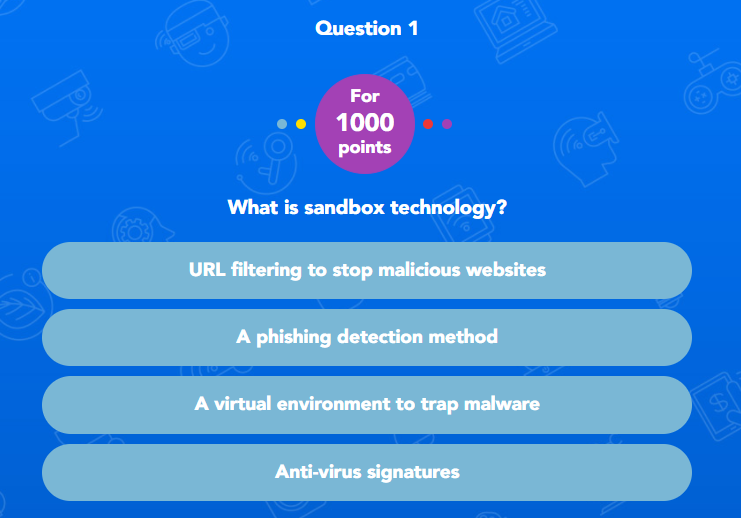
5. Referral programs
Referral programs work splendidly in two ways: they delight your customers and provide them with a mechanism to send you new leads.
Basically, your existing customers are doing your work for you. But you need to provide them with the right tools.
Your referral program landing page should include:
- An enticing image;
- Headline and body copy;
- Clearly list what your customer will get by sharing your brand or product with their friends;
- Clearly state what their friends will get;
- Allow your customers to share your offer easily;
- CTA button.

screenshot from pastaevangelists.com
Want to get top insights for high ROI campaigns?
Subscribe to our blog newsletter!
3 essential strategies to increase website traffic
Looking to increase website traffic? Leverage the power of these 3 essential strategies:
- Blogging
- Social media
- Influencers
1. How to leverage the power of blogging to generate website traffic
To generate website traffic you need content and blogging is the most effective way to create content.
Is blogging easy?
No, it’s not, but companies with blogs generate on average 67% more leads per month than companies that don’t blog.
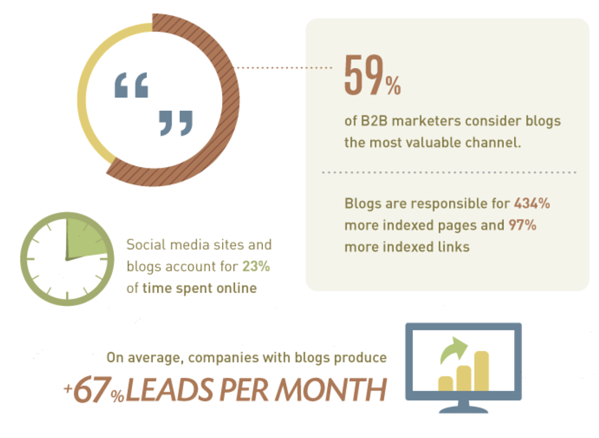
source: hubspot.com
It is a well-known fact that Google loves fresh content so companies that publish new content consistently have a lot to gain and I’m not talking about traffic alone.
Successful companies like HubSpot or Salesforce have grown into content publishing powerhouses. They put out several blog articles a day filled with valuable insights, how-to’s and other recommendations for marketers and sales professionals.
Companies like these two either have a 5-6 writer in-house team or hire freelance writers. Another solution is to welcome guest posts. No matter which option they went with, they have a well-planned editorial calendar for at least 6 months in advance.
It’s totally understandable if your company cannot publish five articles a day, not every company has the human and financial resources of Hubspot and salesforce.
You can start by publishing one article per day. You don’t have a content writer on your team yet? No problem!
Find industry experts or influencers in your niche who are looking to increase their personal brand and invite them to contribute guest blogs.
It’s a win-win situation: contributors boost their visibility and reputation, and your blog benefits from increased traffic from prospects you could turn into leads then customers.
Now that you have writers generating content, it’s time to ensure your published content shows up in Google search results and gets clicked on. In other words: it’s SEO time!
SEO recommendations to get your content to show up in Google search results and get clicked on
1.Keywords with high search volume vs keywords with low search volume
Before jumping into writing content, Nadya Khoja, Chief Growth Officer at Venngage and experienced B2B marketer recommends marketers to determine the search intent of their B2B audience.
Nadya says marketers shouldn’t choose keywords based solely on search volume. When it comes to B2B, marketers should choose keywords and terms that are first and foremost relevant to their audience even if they have a lower search volume.
“Popular searches in your industry will attract more B2C consumers, whereas focused keywords that have a higher value, but a lower search volume, usually fall in the B2B realm.”, says Nadya.
2. Put honey in your titles
The most important element of your blog article is not the contents, but the headline. If the headline is not attractive enough, no one will read the contents.
Think of the headline as honey: it’s sweet and nutritious and bears cannot resist but eat it whenever they find it.
What does a “sweet” headline look like?
A compelling headline:
- offers a solution to the reader’s problem;
- includes an engaging qualifier (i.e.: smart, amazing, easy-to-implement, top, essential, the latest etc);
- is clear on what solution does the article provide (i.e.: recommendations, insights, takeaways, tips, trends etc);
- provides a number (i.e.: 7 recommendations, 25 takeaways).
To help you get really good at writing enticing headlines, use Headline Studio, a Chrome tool that scores your headlines and teaches you how to optimize them.
3. Serve readers with a 3-course meal type of content
Health experts recommend never eat until you are full, eat until you are no longer hungry.
It’s sound advice to prevent overeating related health issues, but that doesn’t apply to content.
Your goal as a content writer is to serve the reader with a 3-course meal type of content.
This type of content satisfies the reader’s appetite in such a way that they don’t need to look anywhere else for delicious content.
It is relevant to the reader and provides valuable information in various forms: how-to, top, round-up, case study, interview or original research.
When the content is valuable, it will get included as a source in other pieces of content and therefore attract further traffic.
2. How to use social media to generate website traffic
For most websites, Google is the first source of paid and organic traffic. Social media comes in second, with Facebook driving the most traffic for business.
Depending on your business, the second social media platform is either LinkedIn or Instagram.
And you should also check out Pinterest because according to the latest reports, each pin can drive up to 2-page visits and 6 pageviews and lasts up to one week compared with Twitter and Facebook whose updates last for 24 minutes and 90 minutes respectively.
Going back to Facebook, what should you write in your post to get your followers to click on the link and visit your page?
Never ever post the link with no copy and expect your audience to click through to your page. It’s unprofessional!
What you need to do is to write a compelling copy that piques the interest of your audience.
Use questions to challenge their assumptions and stoke their curiosity then direct them to your link to find the answers.
3. How to generate website traffic with influencer marketing
The latest stats say influencer marketing strategies focused on branding or engagements generate 8x ROI and according to 71% of marketers, the quality of customers and traffic from influencer marketing is better than other sources.
Influencer marketing is powerful but how should you leverage the power of influencers to generate website traffic?
Here are the main dos and don’ts.
Don’t limit the influencer to sharing a photo holding your product. It’s unprofessional and most of the time it doesn’t work! Yes, I’m repeating myself to grab your attention.
Do have your team and the influencer brainstorm ideas for creative and fun campaigns. The influencer should fall in love with your product and find ways to convey this feeling to their followers.
Which strategy are you using to increase website traffic?
Share in the comments!
Join the Conversation
We’d love to hear what you have to say.
Get in touch with us on our LinkedIn Page, Facebook Page, Twitter or TikTok.
20 essential KPIs you should be tracking to improve your marketing (updated for 2021) Part 1
Looking to learn about KPIs and how you can use them to improve your marketing? Then this article is for you!
- What is a KPI in marketing?
- KPIs vs marketing metrics
- How are KPIs used to measure performance in marketing?
- 20 examples of essential KPIs for marketing
What is a KPI in marketing?
KPI stands for key performance indicator.
A KPI in marketing is a measurable value tied to specific objectives of a marketing campaign.
KPIs help measure marketing effectiveness at the end of a campaign.
KPIs vs marketing metrics
Isn’t KPI the same as marketing metrics?
No, it’s not and you must be able to know the difference between KPIs and marketing metrics.
Marketing metrics are measurable values that include everything from the number of followers of the brand’s page on Facebook, Instagram, YouTube, TikTok to website traffic, email subscribers, MQL (marketing qualified leads) and the list can continue. It’s everything you can measure at any given time.
The KPI belongs to the marketing metrics category, it is indeed a marketing metric itself.
The difference is that the KPIs are tied to a specific goal of a specific marketing campaign whereas marketing metrics are not tied to a specific goal of a specific marketing campaign.
Every marketing campaign has one or several marketing goals. To measure how effective your campaign was to achieve your goals, select the appropriate KPIs.
How are KPIs used to measure performance in marketing?
Before we talk about how to use KPIs to measure and track performance in marketing campaigns, it’s essential to understand the brand’s business goals and objectives.
You cannot measure progress if you don’t know what progress looks like. Or what success means for your business.
So, if you are the leader of your team, share the brand’s business goals for 2021 with your colleagues.
They could focus on revenue (increase sales), suppliers (replace old suppliers with new, more performant ones), employees (reduce employee turnover), profit (increase profit margin) or market (increase market share).
Once everyone in your team is aware of the business goals they need to achieve, you can move on to the next step: establishing marketing goals.
Here are some of the common marketing goals:
- Increase Brand Awareness
- Lead generation
- Promote new products/services
- Target new customers
- Increase website traffic
- Grow your email list
If your business goal is to increase revenue, what marketing campaigns your team needs to create and run in order to achieve it?
You could consider implementing several marketing campaigns. For example, a marketing campaign targeted at new customers or a marketing campaign targeted at your current customers with the goal of upscaling. What would you like them to do: buy more in quantity or buy products that are more expensive?
The KPIs tied to this particular marketing campaign could be 20% new leads generated or 20% customer conversion rate.
20 examples of essential KPIs for marketing
Here are 20 essential KPIs that you should track to measure your marketing performance:
- Email open rates
- Email click-through rates
- Email forward rates
- Newsletter signup conversion rate
- Social media engagement rate
- Social media conversions
- New leads generated
- Cost per lead
- Customer lifetime value
- Returning website visitors
- Goal completion rate
- Marketing revenue attribution
- Customer acquisition cost (CAC)
- Landing page conversion rates
- Traffic-to-lead ratio
- Lead-to-customer ratio
- Customer retention
- Content downloads
- Referral traffic
- Net promoter score
1. Email open rates
You worked hard to gain new subscribers to the company’s newsletter, but all is in vain if your emails remain unopened. Optimize your headlines. Are you sending too many emails per week? If you do, but your subscribers don’t click the unsubscribe button then they wish to receive your emails but they are too often which leads to fatigue.
2. Email click-through rates
Your subscribers are opening your emails – that’s great! One of your email campaign goals is to drive website traffic so the email clickthrough rate is an important KPI. If you note this particular indicator is unsatisfactory (what value did you set for email clickthrough rates?) because the subscribers are not clicking on the links, you should consider the content and the copy. Is the linked content relevant to subscribers? Re-write the copy: don’t use learn more to persuade the subscriber to click the link. Get creative!
3. Email forward rates
The email forward rate is one of the most important KPIs if you are looking to grow a community for the brand. Opening the email and clicking on the content links inside is one thing, but making your message so relevant to your subscribers that they forward it to someone else is a great achievement.
4. Newsletter signup conversion rate
How many people did your email subscribing campaign convert? This KPI shows how well you were able to find a match between the brand’s offering and their interests, to speak to their values and show them your solution to their pain points.
5. Social media engagement rate
They say liking a post is the easiest engagement action that your followers can take whereas commenting is the hardest. Having followers that take the time to express their opinion in a comment to your post is more valuable than receiving likes. It also tells the algorithm that this piece of content is sparking conversations which prompts it to show your post to more people.
6. Social media conversions
It’s nice to have a big number of followers on social media accounts, preferably in the millions. It is an indicator that the brand is popular and a lot of people want to stay connected with the brand. After having said that, let’s also not forget that the algorithm shows your content to a small number of people. Some say it’s 1% or 2%. So this vanity metric is a nice-to-have feature, but it is not essential. What is instead relevant is how many conversions does your social content drive? How many clicks to website? How many email subscribers? How many leads does it generate?
7. New leads generated
Generating new leads is paramount for every brand. You need to constantly show your products or services to new leads gently nudging them to the next step in your marketing and sales funnel.
8. Cost per lead
Lead generation is important, but if the cost of acquiring leads is high, you need to take a step back, analyze every stage of the process and see where you can improve it. The Pirate Funnel may help you pinpoint where your business is losing customers. Check it out!
9. Customer lifetime value
Customer lifetime value is the total revenue you can expect from a customer during the period that they remain a customer. Or simply put: how much are they worth to your brand? For example, Amazon Prime members are worth twice as much as non-Prime shoppers. Prime shoppers spend $1,340 annually, more than twice as much as non-Prime shoppers, who spend $650 annually.
10. Returning website visitors
Having a good amount of website traffic is necessary if you want to run ads, show up in organic search results and gain email subscribers. Your website is owned media, it’s where you control the content – your brand is not at the mercy of any social media algorithms. It’s important to measure the number of new visitors your website gets every month. But equally important is to track how many visitors return to your site. Returning visitors tell you that your website is a relevant and valuable resource for them. It’s how your brand stays top of mind. It’s also easier to convert returning visitors to leads and then customers.
Join the Conversation
We’d love to hear what you have to say.
Get in touch with us on our LinkedIn Page, Facebook Page, Twitter or TikTok.
3 best lead generation tools to get highly targeted leads
Looking for the best lead generation tools to get highly targeted leads and increase sales?
Here is our pick of the best 3 lead generation tools to help you get high quality leads:
1. LinkedIn Sales Navigator

LinkedIn Sales Navigator is one of LinkedIn’s business tools.
LinkedIn Sales Navigator offers you the opportunity to leverage the extensive database of LinkedIn, which has more than 562 million users in more than 200 countries and territories worldwide.
With LinkedIn Sales Navigator you can:
- Target – Find the right people and companies faster;
- Understand – Keep track of key lead and company changes;
- Engage – Reach and engage with prospects.
What can you achieve with LinkedIn Sales Navigator?
- Advanced Lead and Company Search
Find the right people and companies with a search experience that delivers the most relevant prospects.
- Lead Recommendations
Quickly discover the right people at your target accounts with suggestions customized for you.
- CRM Integration
Automatically save the leads and accounts you are selling to and log Sales Navigator activity to CRM in a single click.
- Real-time sales update
Get relevant insights on your accounts and leads, including job changes.
- Notes and Tags
Organize your leads and accounts with tags, and take notes that can be synced back to CRM.
- Who’s viewed your profile
View the expanded list of who’s viewed your profile in the last 90 days.
- InMail Messages
Reach over 500 million members on LinkedIn, even if you’re not connected to them.
- Point Drive Presentations
Package and share sales content in a way that’s better for both the buyer and seller. They can see content without downloading, and you get to track who has viewed what.
- TeamLink
Uncover the best ways to connect with prospects through your company’s combined network.
Newly added features in LinkedIn Sales Navigator tool:
- Deals
Deals allows reps and managers to effectively collaborate on their pipeline. It is a single place to access all pipeline details including the people involved in the deal. This real-time visibility into pipeline leads to extremely productive deal review sessions allowing managers to know when to guide reps and prevent stalling or potentially losing deals.
- The Buyer Circle
The Buyer Circle feature enables reps and managers to better understand the decision makers involved and identify key players who may be missing. With this visibility, sales managers can hold their reps accountable to build relationships with the right people, and also coach reps on strategies to influence each stakeholder and move the deal forward.

image source: pcmag.com
Symantec’s Success Story with LinkedIn Sales Navigator
Challenges
Before using LinkedIn Sales Navigator, Symantec was buying out-of-date lists of contacts and was selling over 200 products by phone. Soon they realised they needed a new sales strategy.
Symantec launched a comprehensive social selling programme centred on LinkedIn Sales Navigator, complete with training, analysis, and reinforcement. This social selling tool enabled Symantec to bring together sales and marketing like never before.
Results:
- Symantec’s SSI (social selling index) increased to an average of 57.8, a full 47% higher than the competition’s average of 39.2;
- Symantec’s Sales Navigator users are 2x as strong at engaging with insights than the competition, 45% more effective at finding the right prospects on LinkedIn, 58% more effective at building relationships and connecting with decision makers;
- Expanded social and brand footprint;
- A greater sphere of influence.
2. Marketo

image source: jobsexpo.ie
Marketo is a marketing automation platform for companies of all sizes. It offers a wide range of solutions: lead management, mobile marketing, customer base marketing, consumer marketing and email marketing.
With Marketo’s lead management tool, companies can attract buyers and nurture them with personalized campaigns, so sales can step in when they are engaged and ready.
Here is what you can achieve with Marketo’s lead management tool:
- Drive More Top-Of-Funnel Activity
Attract top-of-funnel traffic through inbound and outbound programs, and convert leads with landing pages and progressive forms.
- Improve Your Lead Quality
Develop and qualify potential buyers well before they’re passed to sales with relevant, uniquely personalized nurturing campaigns and robust scoring capabilities.
- Help Your Sales Team Win
Prioritize best bets and focus sales conversations with quality and urgency ratings and with integrations with Salesforce.com and Microsoft Dynamics.
- Measure what matters and build on your success
Powerful, easy-to-use reporting lets you attribute success to activities throughout your funnel.
- Scale your campaign execution
Engage potential buyers at scale anywhere in their lifecycle with automated, personalized campaigns and deliver a cohesive and compelling story across all of your channels.

image source: logos.wikia.com
Panasonic’s Success Story with Marketo’s lead management tool
Challenges
Prior to using Marketo’s lead management tool, Panasonic struggled with targeting larger customers without losing any of the run rate business in their channel. With over 460 constantly changing products and 63,000 pages on 72 websites in 22 languages, managing different customer databases was a difficult task to accomplish.
Results
Panasonic has chosen Marketo’s lead management tool in 2013.
Here are Panasonic’s results following 18 months of using this tool:
- Increased share of new sales pipeline: from 10% to 26%;
- 5x growth of the volume of marketing campaigns: over 100 per month without any increase in Marketing staff or budget;
- Increased contacts in the CRM system: from 55,000 to 110,000;
- Valuable insights into the buying patterns and online behaviour of their prospects;
- A competitive advantage.
3. Qualaroo

image source: qualaroo.com
Qualaroo is a lead-generation tool that focuses on capturing qualitative insights.
How can you benefit from Qualaroo’s lead-generation tool?
- Understand and update buyer personas
Engage users intelligently by adapting to what actions they’ve taken on your website or app.
Deliver customized content to users specific to where they came from geographically.
Target users based on how they landed on your website by URL, campaign etc.
- Conduct sentiment analysis
With keyword analysis and emotional scores, you can create unique experiences for customers based on how they feel about your product or service.
Qualaroo’s sentiment analysis engine is powered by IBM Watson to help you make decisions in real-time based on the feedback collected.
- Customer decision analysis
Customer decision analysis is an emerging field focused deeply and specifically on four key components:
- timing (when you should ask),
- analysis (how to process hundreds of responses),
- questioning (how to phrase questions, what topics to cover, and what gets customers engaged and talking)
- presentation of results (present all data you have collected to drive real change within your company).
- Growth direction
Because your survey results show you what to do next, your surveys become a mechanism for your company’s growth.

image source: pcmag.com
Hootsuite’s Success Story with Qualaroo
Challenges
Hootsuite wasn’t happy with how their website’s landing page converted visitors to customers.
Using Qualaroo’s surveys, Hootsuite found that 65% of their landing page visitors needed more information before they could make a buying decision. Even though their branded traffic knew the name “Hootsuite” enough to search for it, they didn’t understand what Hootsuite actually does—and that was because the landing page didn’t communicate Hootsuite’s core value proposition.
Results
Qualaroo showed the direction where Hootsuite needed to make a change. Hootsuite updated their landing page to clarify their product’s core functions. This change resulted in a 16% lift in conversion.
How to Gain More Leads with Conversational Marketing
Do you want to gain more leads? Here is the most successful lead generation strategy in 2018: conversational marketing!
By the end of this article, you will learn about conversational marketing and how to use it to gain more leads.
Conversational marketing – what is it?
Conversational marketing is defined as a one-to-one approach to marketing that companies use to shorten their sales cycle, learn about their customers and create a more human buying experience. The term “conversational marketing” was coined by Dave Gerhardt, the CEO at Drift, one of the leading conversational marketing platforms.
Conversational marketing – 5 features
- Real-time;
- Scalable;
- Focused on engagement;
- Personalized;
- Built-in feedback loop.
Why should you use conversational marketing?
Conversational marketing means returning to the foundation of marketing: having conversations with people.
The power shift between brands and customers has changed. Today customers are in control of your brand, your products and they dictate the terms of communication. Your brand is expected to meet their needs, be available for answering their questions around the clock and have an personalised approach. Everyone likes to feel important.
Using conversational marketing, your brand has the opportunity to achieve exactly that: build trust and connections with your customers by making them feel important.
No more cold calls, lead capture forms and waiting for follow-ups
Conversational marketing is all about your customers. Put yourself in their shoes and answer truthfully: do you like answering to cold calls? Exactly! No one does.
Conversational marketing uses targeted, real-time messaging and intelligent chatbots. This means your leads will no longer have to wait for follow-ups and are able to engage with your company when and how it’s convenient for them.
How to use conversational marketing for lead generation
1 Capture – 2 Qualify – 3 Connect
There are two places where you can put your chatbots on:
- On your website for live one-to-one discussions;
- In messaging apps: Messenger, WhatsApp, Slack, Skype etc.
Chatbots on your website
I. Capture
Capture high-value leads using chatbots. You can place your company’s chatbot on your website and/or messaging apps.
Here are 4 examples of the best website pages to put your chatbot on via impactbnd.com:
1. High-intent pages
Integrate your chatbot with the pages which are indicative that your visitors may have the intention of working with you.
Such pages are:
- Pricing pages,
- Services pages,
- Bottom-of-the-funnel landing pages,
- Other pages that are relevant to your visitor’s buying journey.
When your customers visit these pages you know they will have specific questions regarding your services. They may ask which one of your services will solve their problem or which pricing model is right for them. Use the chatbot to ask qualifying questions and then program it to forward the lead to the appropriate company representative.
2. High-traffic pages
High-traffic pages are:
- Homepages;
- Blogs;
- Articles.
Placing your chatbot on these pages means you have the opportunity to focus on providing value to as many people as possible, but you can also gain valuable feedback on what is and what isn’t working.
3. High-intent (Negative)
Pages that show high but negative intent are your email unsubscribe page.
Your visitors are there because something is wrong with the way your company is engaging with them. Maybe your emails are too sales-oriented, or your frequency is higher than it should be. This is your opportunity to find out the reason they are unsubscribing and a chance to improve your communication.
Remember that frustration underlies your visitor’s reason for unsubscribing. Giving him/her the opportunity to voice their frustrations is a great way to show them your company values them as an individual. Your chatbot may even change your visitor’s mind and reconsider unsubscribing.
Do you want to keep your subscribers happy?
Read our article Stop making these 5 email marketing mistakes.
4. Blog Article
The blog is your company’s tool for brand awareness increase and trust-building. Let’s say you have just read a blog article on influencer marketing. This article sparked a question but you don’t want to go back to Google and search for an answer because it is time-consuming.
Why not ask the author of that article in real-time? When it comes to putting bots on educational content, it’s all about enabling people to learn better and understand more.
The result will be a visitor who trusts you more!
II. Qualify
The latest study on B2B lead generation has found that the lack of quality leads is the second challenge marketers struggle with (source: bopdesign.com).
If this is the case for you, then a chatbot can step up to the plate and solve this problem. How? By asking questions that qualify the respective lead.
It’s time effective and allows you to engage with qualified leads only.
III. Connect
The chatbot doesn’t replace your sales or customer experience team. It functions as an intermediary between the lead and the appropriate company representative. View the chatbot as an assistant: instead of manually booking the appointment with your lead, the chatbot is doing it for you.
Chatbots in messaging apps – the power couple of lead generation and sales
Facebook studies found the following statistics related to Messenger usage behaviour:
- 53% of people are more likely to shop with a business they can message (“Facebook Messaging Survey” by Nielsen);
- 20 Million businesses message with people every month (January 2018, Facebook);
- 2 billion messages are sent on Messenger between people and businesses each month.
So long business email marketing, phone calls and SMS! Messaging apps are the royalty of modern-day communication. If your company is not using them, you are missing sales opportunities.
Do you want to learn how to use this power couple to your advantage?
Read our article How to use chatbots to increase sales.
Conversational marketing – benefits for your company and customers
For your company:
- A new source of leads;
- Shortened sales cycle;
- Increased sales pipeline;
- A new source of information about your customers and how they are using your products;
- Increased brand awareness.
For your customers:
- Supports your company be customer’s top of mind;
- Real-time assistance to their needs;
- Real-time answers to their questions;
- Trust building;
- You create a more human buying experience;
- Enhanced user experience.
Conclusions
Conversational marketing is not a new concept. Driving conversations about products and services is the main function of marketing. It’s not the goal of marketing strategy that changed, but the tools marketers can use to achieve that goal: chatbots and messaging apps.
The secret of a successful marketing strategy is closely related to customer experience. Give your customers what they need, use the tools they are already using, listen to them and make them feel like they are valuable assets for your company.
How Can Live Videos Help You Get Leads
Use teasers
“To attract potential leads, promote your live video with a catchy title or appealing topic. Then as you cover the topic in the video, structure the presentation so it leads viewers into your marketing and sales funnel and takes advantage of the interaction that live video offers,” wrote Social Examiner.
When you structure a live video, you want viewers to stay until the end when you pitch your product or service. Therefore, make sure you give them an introduction and explain what you plan to discuss, offering them a hook to what they might miss if they don’t watch until the end. That will keep them connected and wanting to hear and see more.
Landing pages
Landing pages are meant for conversion. But that can only happen if the videos on them are able to attract their target, by being catchy and engaging. Video can help you do this by luring people in through humor or captivating storytelling. Videos are 12 times more likely to be watched than text is to be read. By creating an interesting video you will be able to keep the people longer on your landing page and convince them to continue on to the rest of your landing page content.
The best practice for capturing leads when using promotional videos on landing pages is to use a call-to-action (CTA) or auto-redirect. A CTA at the end of your video invites viewers to take the next step and an auto-redirect sends viewers to the rest of your landing page immediately upon completion, thus giving them the opportunity to further engage with your brand.
YouTube Annotations and other forms of pop-out CTAs are great additions to make sure your viewers are engaging with your content. You want your viewers to take action, and including these elements during a video is a great way to engage them in the moment—for example, if you are discussing a particular service or product and that annotation text link pops up right at that moment. Moreover, this is a great way to link people to other content you want them to view.
Offer demos of your products
One-off demo videos represents a great way to answer a question or highlight a specific product feature while engaging with leads in a personalized, helpful way. And more than anything, they are a really effective way of interacting.
Product videos are some of the most commonly produced and most frequently viewed videos. Rather than just capturing the standard information of name, company, email address, and phone number, use these types of videos, instead, as opportunities to learn more about your prospects. as the ultimate goal is to capture information that will help you to better qualify your leads. In order to succeed at that chapter you must make sure your videos contain interactive elements such as survey questions or polls, that will encourage your target to engage more.
Ask your audience to respond through a live chat bar, as this will give you the opportunity to see if they’re interested in the product or service you have to offer. This tactic will help you follow up with the right people after the live video ends and make more sales.
Offer educational, high-value content
People are drown to great content,from which they can learn more. Don’t make your live video just a sales pitch, make sure that at the end of the day the people watching are left with great pieces of information. That will make them come back to you over and over again.
Give discounts
Videos sale better than images, just as images sale better than plain texts. Therefore, don’t forget to offer people discounts if you are promoting a product or a service. This is a great way to attract new consumers, but also to keep the ones you already have. By giving the discounts only to the people watching the live video, it also offers them the feeling of exclusivity we all crave for.
How to make it work for your brand with Facebook’s new changes
After the new Facebook News Feed changes, all of the marcomm industry has been left wondering what are the best ways of keep on bringing success for the brands and the companies.
We are offering you some solutions that we believe will help you and your business:
Put more emphasize on the content and its value. Even you will post less frequently, try and create content that will stimulate the conversation, bringing more comments and shares.
Avoid click and engagement bait
Use Facebook Live. Live videos get the best interaction of Facebook of all the content posted and,moreover, bring instant interaction and reaction from the followers. A manner to attract more people to your live video is to announce your followers you will have a video session and when it will happen, plus add people in your video and invite people to watch. Moreover, the viewers can interact by posing open questions or by submitting questions during the live feed.
Use the “See First” option. What it happens is that when your followers activate this option they’re less likely to miss your updates. All they have to do is click on “Following” and then “See First” on your page and everything is settled.
Get into Messenger Chatbots, learn about them and use them. They will allow you to nurture leads and sell.
“Businesses in the travel, finance, media and entertainment, health, and retail sectors in particular have all found success with these pocket-sized personal assistants. For example, you can open up Facebook Messenger at breakfast and ask your weather bot what Mother Nature has in store for you that day. Then you can ask your favorite newspaper bot for the latest sports or business headlines. Planning a trip? Message a travel bot for flights and hotel recommendations, to rent a car, and more. Bots use AI technology to understand your question, find the right response, and deliver it in as conversational and “human” a way as possible,” wrote Rob Mathison for Hootsuite.
Learn how to use to perfection Facebook ads. Even the advertising politics are in a continuous change, mastering your ads’ strategy is the way to reach the best your target.


